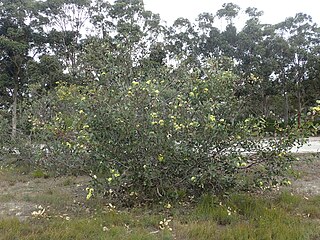
Eucalyptus preissiana, commonly known as bell-fruited mallee, is a species of small tree or shrub that occurs in an area between Albany and Esperance in Western Australia. It has a spreading habit, smooth bark, elliptical to egg-shaped or oblong leaves, flower buds in groups of three, yellow flowers and cup-shaped, conical or bell-shaped fruit.
Eucalyptus blaxellii, commonly known as the Howatharra mallee, is a mallee that is endemic to Western Australia. It has smooth bark, linear to narrow lance-shaped adult leaves, flower buds arranged in groups of seven, white flowers and cup-shaped to conical fruit.

Eucalyptus burdettiana, commonly known as Burdett gum or Burdett's mallee, is a species of flowering plant in the family Myrtaceae and is endemic to Western Australia. It is a mallee or shrub with smooth bark, lance-shaped adult leaves, flower buds with an elongated horn-shaped operculum, greenish-yellow flowers and cup-shaped or bell-shaped fruit.
Eucalyptus crispata, commonly known as the Yandanooka mallee, is a species of tall mallee that is endemic to a small area on the east coast of Western Australia. It has a stocking of rough bark near the base of its trunk, smooth grey bark above, lance-shaped adult leaves, flower buds in groups of between nine and eleven, whitish to yellowish cream flowers and cup-shaped, barrel-shaped or hemispherical to cylindrical fruit.

Eucalyptus effusa, commonly known as rough-barked gimlet, is a species of mallee or small tree that is endemic to Western Australia. It has thin, rough bark on the base of the trunk, smooth bark above, linear to narrow lance-shaped adult leaves, flower buds arranged in groups of seven, white flowers and cup-shaped to conical fruit.
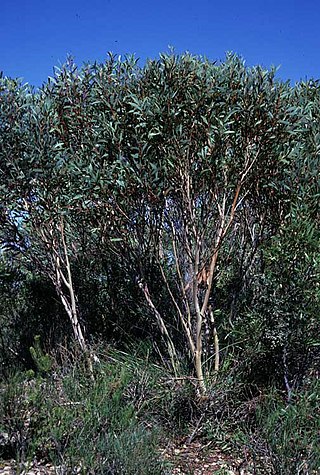
Eucalyptus erectifolia, commonly known as Stirling Range mallee, is a species of mallee that is endemic to Western Australia. It has smooth bark, narrow lance-shaped adult leaves, flower buds in groups of between seven and thirteen, white flowers and cup-shaped fruit.

Eucalyptus jucunda, commonly known as Yuna mallee, is a species of mallee or small tree that is endemic to Western Australia. It has smooth bark, lance-shaped to curved adult leaves, flowering buds in groups of seven or nine, white or cream-coloured flowers and barrel-shaped or shortened spherical fruit with an unusually narrow opening.

Eucalyptus lateritica, commonly known as laterite mallee, is a species of mallee that is endemic to a small area in the south-west of Western Australia. It has rough bark on the lower half of the trunk, smooth grey bark above, lance-shaped adult leaves, flower buds in groups of nine or eleven, white flowers and shortened spherical fruit.
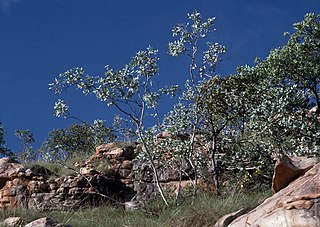
Eucalyptus mooreana, commonly known as Moore's gum, mountain white gum or King Leopold Range mallee, is a species of stunted, straggly tree or mallee that is endemic to the Kimberley region of Western Australia. It has smooth, powdery white bark, a crown of juvenile, sessile, stem-clasping leaves arranged in opposite pairs, flower buds arranged in groups of seven, white flowers and cup-shaped to hemispherical fruit.
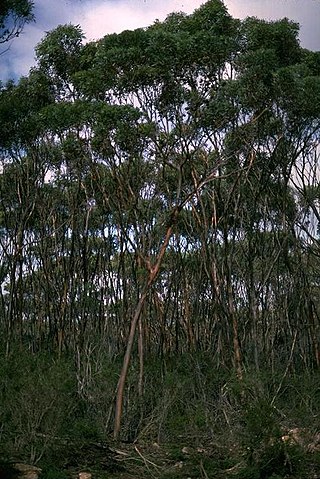
Eucalyptus newbeyi, commonly known as Beaufort Inlet mallee, is a species of mallee that is endemic to a small area on the south coast of Western Australia. It has smooth, mottled bark, narrow leaves, flower buds usually in groups of seven, yellowish green flowers and bell-shaped to conical fruit.

Eucalyptus oldfieldii, commonly known as Oldfield's mallee, is a species of mallee or tree that is endemic to Western Australia. It has a sprawling or spreading habit, mostly smooth greyish or brownish bark, lance-shaped adult leaves, flower buds in groups of three, white flowers and conical, cup-shaped or hemispherical fruit.
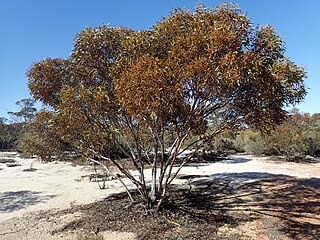
Eucalyptus pileata, commonly known as the capped mallee, is a species of mallee that is native to South Australia and Western Australia. It has smooth greyish bark, narrow lance-shaped adult leaves, flower buds in groups of seven, white flowers and cup-shaped, conical or barrel-shaped fruit.
Eucalyptus planipes is a species of mallee that is endemic to Western Australia. It has smooth bark, lance-shaped adult leaves, flower buds in groups of three and conical fruit.
Eucalyptus repullulans, commonly known as chrysoprase mallee, is a species of mallee that is native to arid parts of Western Australia and the far north-west of South Australia. It has smooth bark, lance-shaped adult leaves, flower buds in groups of between seven and thirteen, cream-coloured flowers and cup-shaped, cylindrical or conical fruit.
Eucalyptus rigens, commonly known as saltlake mallee, is a species of sprawling mallee that is endemic to the southwest of Western Australia. It has smooth bark, lance-shaped adult leaves, flower buds in groups of three on a flattened peduncle and sessile, ribbed fruit.
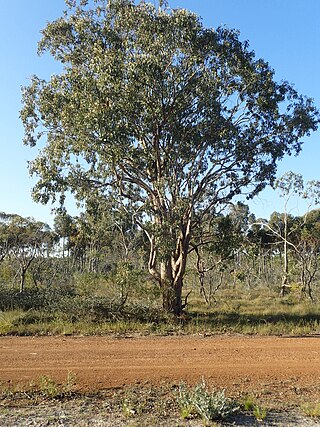
Eucalyptus sheathiana, commonly known as ribbon-barked gum or ribbon-barked mallee, is a species of tree or a mallee that is endemic to Western Australia. It has smooth bark that is shed in long ribbons, lance-shaped adult leaves, flower buds in groups of seven, creamy white flowers and conical to cup-shaped fruit.
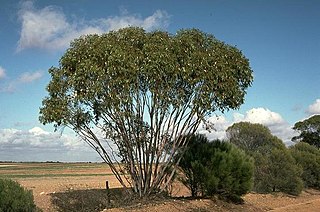
Eucalyptus stowardii, commonly known as fluted-horn mallee, is a species of mallee that is endemic to the south-west of Western Australia. It has smooth bark, lance-shaped adult leaves, flower buds in groups of seven, creamy white flowers and ribbed, cylindrical to cup-shaped fruit.

Eucalyptus carnei, also known as the Carne's blackbutt, is a species of tree or mallee that is endemic to an area in central Western Australia. It has smooth grey bark, lance-shaped adult leaves, flower buds in groups of seven, creamy white flowers, and cup-shaped to conical fruit.

Eucalyptus corrugata, also known as rough fruited mallee or rib-fruited mallee, is a species of tree or mallee that is endemic to Western Australia. It has rough scaly or fibrous bark on the lower part of its trunk, smooth bark above, glossy, lance-shaped adult leaves, prominently corrugated flower buds arranged in groups of three in leaf axils and ribbed, conical to cup-shaped fruit.

Eucalyptus crucis is a species of mallee that is endemic to Western Australia. There are three subspecies, commonly known as silver mallee or Southern Cross mallee,, narrow-leaved silver mallee, and Paynes Find mallee,. It has rough bark that is shed in curling flakes, more or less round, glaucous juvenile leaves, egg-shaped intermediate leaves and lance-shaped adult leaves. The type of bark and the proportion of juvenile, intermediate and adult leaves in the crown of mature plants varies with subspecies. The flower buds are arranged in groups of seven in leaf axils, the flowers are whitish to pale yellow and the fruit is a conical to hemispherical capsule.


















